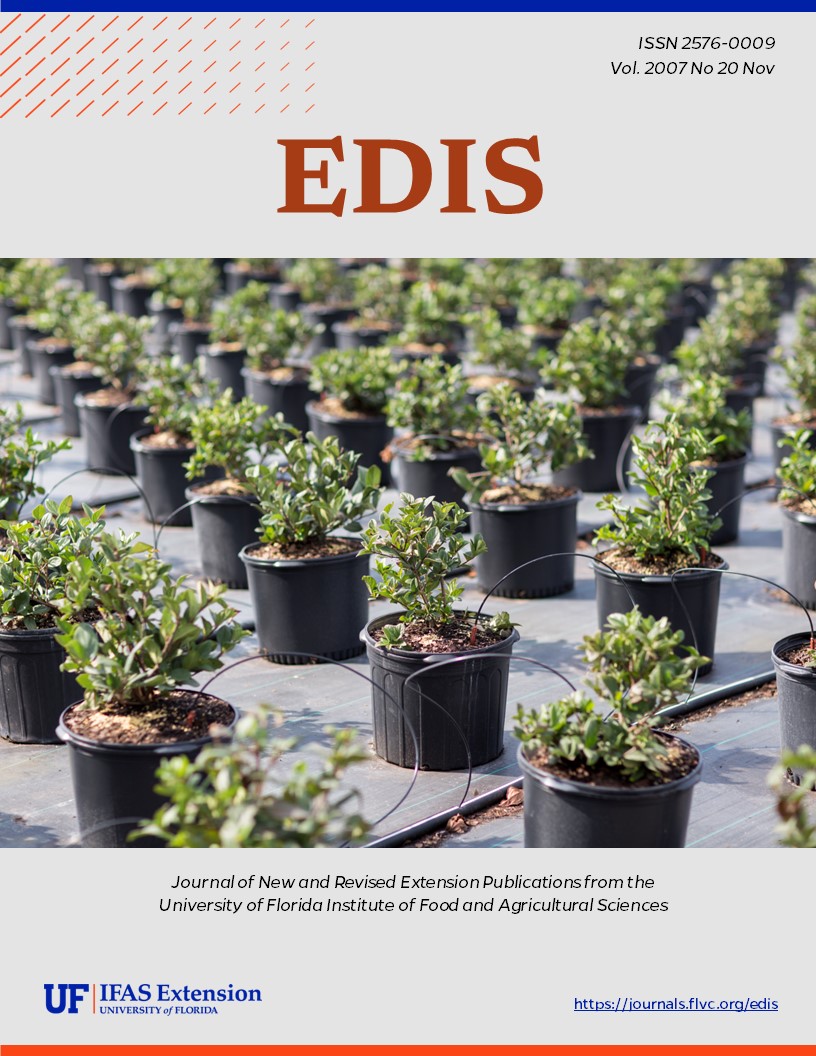Abstract
FA147, a 5-page fact sheet by Christian L. Miller, Cortney L. Ohs, and R. LeRoy Creswell, introduces this lobster with whip-like antennae for aquaculture in Florida. It gives description and natural history and discusses culture methods, market, and diseases that may affect its aquaculture potential. Includes references and recommended additional reading Published by the UF Department of Fisheries and Aquatic Sciences, September 2007.
Ask IFAS: Candidate Species for Florida Aquaculture series (ufl.edu)
References
Assad, L.T., D.S. Gondim, and M Ogawa. 1996. The growout of spiny lobster juveniles in marine cages. Arquivos Cienias do Mar, Fortaleza 30: 13-19.
Brown, P., R. Leader, S. Jones, and W. Key. 1999. Use of New Water-stable Feed for Culture of the Spiny Lobster (Panulirus argus) . Purdue Experimental Station Technical Publication. 1: 1-8.
Butler, M.J. and W.F. Herrnkind. 1989. Are artificial Witham surface collectors adequate indicators of Caribbean spiny lobster, Panulirus argus, recruitment. Proceedings of the Gulf and Caribbean Fisheries Institute. 42: 135-136.
Cox, S.L. and M. Davis. 2006. The effect of feeding frequency and ration on growth of juvenile spiny lobster, Panulirus argus (Palinuridae). Journal of Applied Aquaculture 18(4): 33-43. https://doi.org/10.1300/J028v18n04_03
Creswell, R.L. 1984. Increased production of spiny lobsters (Panulirus argus) through post harvest impoundment. Proceedings of the Gulf and Caribbean Fisheries Institute. 43: 23-35.
Jeffs, A.G. and P. James. 2001. Sea-cage culture of spiny lobster Jasus edwardsii in New Zealand. Marine and Freshwater Research. 52: 1419-1424. https://doi.org/10.1071/MF01064
Jeffs, A.G. 2003. The Potential for Crayfish Aquaculture in Northland. NIWA Project No. ENT03101. Aquaculture Development Group Enterprise Northland. Auckland, New Zealand.
Jeffs, A. and M. Davis. 2003. An assessment of the aquaculture potential of the Caribbean spiny lobster, Panulirus argus. Proceedings of the Gulf and Caribbean Fisheries Institute. 54: 413-426.
Kittaka, J. 1997. Culture of larval spiny lobsters: a review of work done in northern Japan. Marine and Freshwater Research. 48(8): 923-930. https://doi.org/10.1071/MF97163
Lellis, W.A. 1991. Spiny lobster: A mariculture candidate for the Caribbean? World Aquaculture. 22: 60-63.
Lipcius, R.N. and D.B. Eggleston. 2000. Ecology and fishery biology of spiny lobsters. In: Spiny Lobsters:Fisheries and Culture. Eds B.F. Phillips and J. Kittaka. Pp. 1-41. Fishing News Books. Oxford. https://doi.org/10.1002/9780470698808.ch
Lozano-Alverez, E. 1996. Ongrowing of juvenile spiny lobsters, Panulirus argus (Latreille, 1804) (Decapoda, Paliunridae), in portable sea enclosures. Crustaceana. 69: 958-972. https://doi.org/10.1163/156854096X00402
Marx, J.M. and W.F. Herrnkind. 1986. Species Profiles: life histories and environmental requirements of coastal fishes and invertebrates (south Florida) spiny lobster. U.S. Fish and Wildlife Service Biological Report 82(11.61). U.S. Army Corps of Engineers, TR EL-82-4. 21pp.
National Marine Fisheries Service. NMFS Annual Commercial Landings Statistics. http://www.st.nmfs.gov/st1/commercial/landings/annual_landings.html
Power, R., J.L. Murno, M. Diffenthal, and G. Lane. [In Press]. Preliminary investigations into the feasibility of small-scale commercial aquaculture of Panulirus argus, based on collection of pueruli from the wild. Proceedings of the Gulf Caribbean Fisheries Institute.
Sharp, W.C., W.A. Lellis, M.J. Butler, W.F. Herrnkind, J.H. Hunt, M. Pardee-Woodring, and T.R. Matthews. 2000. The use of coded microwire tags in mark-recapture studies of juvenile Caribbean spiny lobster, Panulirus argus. Journal of Crustacean Biology. 20: 510-521. https://doi.org/10.1163/20021975-99990067
Shields, J.D. and D.C. Behringer Jr. 2004. A new pathogenic virus in the Caribbean spiny lobster Panulirus argus from the Florida Keys. Diseases of Aquatic Organisms. 59: 109-118. https://doi.org/10.3354/dao059109
Sjoken, R. 1999. The Formulation and Evaluation of an Artificial Feed for the Growout of Spiny Lobsters. MS Thesis, Graduate School of the Florida Institute of Technology. Melbourne, Florida USA.
Ting, R.Y. 1973. Culture potential of spiny lobster. In: Proceedings of the 4th Annual Workshop, World Aquaculture Society. Pp 165-170. Baton Rouge, Louisiana, USA. https://doi.org/10.1111/j.1749-7345.1973.tb00104.x
Witham, R., R.M. Ingle, and E.A. Joyce, Jr. 1964. Notes on postlarvae of Panulirus argus. Quarterly Journal of the Florida Academy of Science. 27: 289-297.
Witham, R., R.M. Ingle, and E.A. Joyce, Jr. 1968. Physiological and ecological studies of Panulirus argus from the St. Lucie estuary. Fla. Board. Cons. Mar. Res. Lab. Tech Ser. No. 53. 31 pp.
Witham, R. 1973. Preliminary thermal studies on young Panulirus argus. Florida Scientist. 36: 154-158.
Yeung, C. and M.F. McGowan. 1991. Difference in inshore-offshore and vertical distribution of phyllosoma larvae of Panulirus, Scyllarus, and Scyllarides in the Florida Keys in May-June 1989. Bulletin of Marine Science. 49: 699-714.

